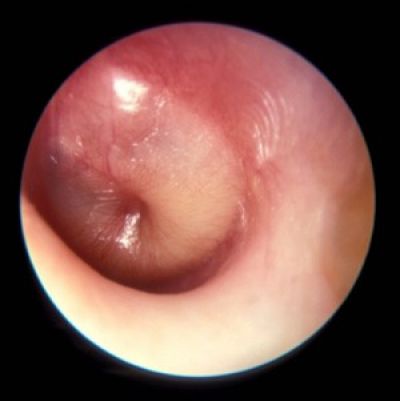Glue ear is fluid in the middle ear, behind the ear drum. Some other names you may hear glue ear called are Otitis Media with Effusion or maybe Mucoid Otitis Media.
How did it get there?
The lining of the middle ear ‘sweats’ fluid all the time and this fluid usually empties out automatically when our ears “pop”; for example when we swallow or yawn. Air would normally enter the middle ear through the Eustachian tube, which is a tube that runs between the middle ear and the back of the nose, which is closed but opens for a moment every time we swallow. If the Eustachian tube is not working properly, from swelling from an infection, even a head cold, it may not allow air to get into the middle ear, or the fluid to get out. The fluid is thin at first, but if the middle ear stays irritated the fluid can’t get out and air also can’t get in. This fluid may then become thick, like “glue”.
How could this glue affect my child?
Thick fluid blocks some of the sound in the ear so your child may seem deaf (and need the TV up louder) or not paying attention. It also sometimes makes them off-balance or irritable. If this occurs then your child needs to see your family doctor.
This ‘glue’ acts like a very good ear plug and blocks a lot of the sound so your child cannot hear properly. This type of hearing trouble is called a ‘conductive’ hearing loss.
Children should not be left for long periods with untreated glue ear. The hearing loss which occurs may affect your child's speech development, their understanding of language, and possibly their reading and spelling.
How can it be treated?
Thick fluid may remain trapped in the ear after a middle ear infection. It can take up to 3 months to clear. Sometimes this thick fluid develops even when there has been no infection. If there was an infection then antibiotics will be prescribed If your child is hearing and speaking well there is no rush to treat this thick fluid.. Your doctor will need to check the ears every month or so until the fluid has gone.
If the thick fluid persists or if you have any concern about their hearing or their speaking then referral to an ear nose and throat specialist is recommended.
Your child may need grommets (tiny tubes) put in the eardrum to let air into the middle ear and allow the fluid to drain naturally.
What are grommets?
Grommets are very small ventilation tubes made of plastic that are about 2mm wide. The grommet sits in the eardrum with one flange sitting on the inside and one on the outside of the eardrum.
Grommets are known by a few different names but they all work in the same way to allow air into the middle ear. Some of the other names are ventilation tubes, drainage tubes, Shepard’s tubes, Collar button tubes and T- tubes. You may hear other names as well so ask your doctor to explain this to you. The names describe tubes of various shapes and sizes.
How do they work?
Grommets are ventilation tubes which have a small hole in the centre which allows fresh air to enter the middle ear to keep it free of fluid.
Once air can enter the middle ear it helps to improve your child’s hearing by allowing the tiny bones of hearing to move freely again.
The grommets will gradually fall out of the drum after three - eighteen months. Most children’s hearing will recover fully. The fluid may come back in some children and further treatment will be needed. Some children need grommets again.
Will my child need to go to hospital to have grommets inserted?
Yes, your child will need to be in hospital to have the grommets inserted. It is a day only procedure so they will not need to stay overnight unless your child is having another operation at the same time.
Your child will come into hospital the day they are having their operation. It is important that they don’t have anything at all to eat or drink before the operation. The hospital will advise you what time your child needs to be ‘nil by mouth’.
Before the operation commences your child will be given an anaesthetic to put them into a deep sleep so that they will not feel any discomfort during the procedure.
After surgery your child will be able to go home within a couple of hours, when they have woken up and had something to drink.
What do I need to know about grommets when at home?
- Your child shouldn't have much pain after the operation. You should contact a doctor if they have a lot of pain after the operation, or if discharge (fluid) from the ear continues for more than 5 days.
- After your child has the grommets inserted you need to be careful of water getting in the ears until the grommets have come out of the ear drum and it is fully healed.
- It is particularly important to keep dirty water (which contains a lot of germs) out of the ear while grommets are in.
- ‘Dirty water’ is bath water, heated pools, spas, and rivers, lakes, dams and creeks.
- Showering, even with hair shampooing is OK. So it is easier to shower rather than bathe your child.
- If a bath is used then have it very shallow and wash hair with clean water from the hand basin or use a hand spray attachment.
If none of this is possible then earplugs should be used. There are a few different things you can use as ear plugs:
- Custom made ear plugs can be made by hearing aid suppliers
- Soft plastic plugs can be bought at some shops
- Silicone ear putty
- Blu-tack
- Cotton wool smeared with Vaseline
It is important that if you use putty or blu-tack that you use a piece as big as your child’s outer ear and not a piece small enough to get stuck in the ear canal.
Can we still go swimming?
Yes, but not for the first week after the operation.
Swimming at an ocean beach needs no special care but in other places ear plugs should be used and these need to be supported with a swimming cap or an ear wrap-type headband.
What if water gets in my child’s ears while the grommets are there?
Chances are nothing will happen. But an ear infection can develop. This will be seen as discharge (fluid) coming from the ear needing treatment with ear drops. Your child should not swim until the infection is gone.
Swimming with an ear infection can spread the infection to other people.
Do I need to know anything else?
Because hearing loss occurs in glue ear, it is very important that your child has a hearing test after the glue ear is better; that is soon after the grommets have been put in, or if the glue has gone away itself.
Hearing tests for children are available in some hospitals, community health centres, in some ear, nose and throat specialists' offices or at Australian Hearing Services. If the hearing is not back to normal, further investigation is needed.
If your child has grommets they will need to have their ears checked regularly to see if the grommets are still in the ear drum and still working.
Remember
- Glue ear should not be left untreated for long periods of time.
- Your child should have a hearing test after they have their grommets.
- Your child should use water precautions when in the bath or swimming in dirty water until the grommets are out.
References
Aussie Childcare Network acknowledges the co-operation of The Children’s Hospital at Westmead, Sydney Children’s Hospital and Kaleidoscope, Hunter Children’s Health Network in making this fact sheet available.
Disclaimer: This article is for education purposes only. Please consult with your doctor or other health professional to make sure this information is right for your child.






